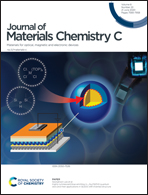Influence of oversized cations on electronic dimensionality of d-MAPbI3 crystals†
Abstract
The incorporation of a large ion which violates the Goldschmidt geometric tolerance factor, such as hydroxyethyl ammonium (HEA+), into lead halide perovskites leads to the formation of a lead and halide deficient crystal. The resulting material has a long-range order typical of a three dimensional crystal, which is locally disrupted by octahedron-free channels. Here, we report on low-temperature magneto-optical spectroscopy of lead- and iodine-deficient MAPbI3 (d-MAPbI3) with varying concentrations of Pb–I vacancies in high magnetic fields of up to 68 T. The hybrid nature of the structure of this material is reflected by the surprising coexistence of 3D-like optical transitions at low energy (1.54 eV) and lower dimensional (LD) transitions at high energy (1.9–2.4 eV). The intensity variation between the LD and 3D-like transitions when the concentration of Pb-I vacancies is varied indicates a strong correlation between the structural modifications introduced by the oversized cations and the optical properties. The reduced dimensionality associated with the high energy transitions is supported by the observed smaller diamagnetic shift and shorter carrier lifetimes.



 Please wait while we load your content...
Please wait while we load your content...